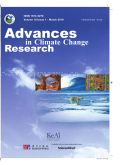- 钛学术文献服务平台 \
- 学术期刊 \
- 基础科学期刊 \
- 天文学、地球科学期刊 \
- 气候变化研究进展(英文版)期刊 \
Impacts of global warming on southern California's winegrape climate suitability
Impacts of global warming on southern California's winegrape climate suitability
基本信息来源于合作网站,原文需代理用户跳转至来源网站获取
摘要:
Southern California has seen a resurgence of winegrowing regions in the past few decades, however the future of winegrape climatic suitability in the area has not been exhaustively explored. This study evaluated the future climate suitability for the cultivation of winegrape and potential global warming impacts on southern California's winegrowing regions through a series of high-resolution surface air temperature and precipitation projections obtained with the WRF-SSIB regional climate model. Results reveal that by mid-21st-century the surface air tem-perature will increase by approximately 1.2 ℃, while average precipitation will decrease by as much as 11%in the southern winegrowing areas under the Intergovernmental Panel on Climate Change high greenhouse-gas emissions scenario. Evaluation of bioclimatic suitability indices indicate increases in heat accumulation for all major winegrowing areas; including an increase of about 10% in growing-degree day, while morning low temperatures in September may experience increases of approximately 11%in the future, thus impacting negatively the ripening stage of grapevines and leading to changes in wine composition and quality. Additionally, the extent of areas classified under the cool to warm climate suitability categories could decrease by nearly 42%in the study area by 2050. Conditions in southern California are already warm and dry for viticulture and continuing heat accumulation increase, along with rainfall reduction, could potentially place additional stress to winegrape crop in the area, including advanced phenological timing and moisture deficit stress that could lead to decreases in yield. The projected decline in viticulture suitability highlights the need for adaptive capacity within this sector to mitigate the impacts of global warming. Possible mitigating strategies include planting hotter climate grape varieties, moving vineyards to regions that are more suitable in the future, and adopting dry-farming techniques.

推荐文章
Concentration-discharge patterns of weathering products from global rivers
Concentration-discharge
Rivers
Silicate weathering
Solutes
U-Pb zircon age of the base of the Ediacaran System at the southern margin of the Qinling Orogen
Neoproterozoic
Cap dolostone
K-bentonite
U-Pb age
Qinling Orogen
NSEC教材中“warming-up”板块的分析与评价
“warming-up”板块
教材分析
教材评价
The influence of climate and topography on chemical weathering of granitic regoliths in the monsoon
Granitic regolith
Chemical weathering
Supply-limited weathering
Kinetic-limited weathering
内容分析
关键词云
关键词热度
相关文献总数
(/次)
(/年)
文献信息
| 篇名 | Impacts of global warming on southern California's winegrape climate suitability | ||
| 来源期刊 | 气候变化研究进展(英文版) | 学科 | |
| 关键词 | |||
| 年,卷(期) | 2020,(3) | 所属期刊栏目 | Impacts of climate change |
| 研究方向 | 页码范围 | 279-293 | |
| 页数 | 15页 | 分类号 | |
| 字数 | 语种 | 英文 | |
| DOI | |||
五维指标
引文网络
引文网络
二级参考文献 (0)
共引文献 (0)
参考文献 (62)
节点文献
引证文献 (0)
同被引文献 (0)
二级引证文献 (0)
1991(1)
- 参考文献(1)
- 二级参考文献(0)
1996(1)
- 参考文献(1)
- 二级参考文献(0)
1998(1)
- 参考文献(1)
- 二级参考文献(0)
2000(1)
- 参考文献(1)
- 二级参考文献(0)
2001(1)
- 参考文献(1)
- 二级参考文献(0)
2004(2)
- 参考文献(2)
- 二级参考文献(0)
2005(3)
- 参考文献(3)
- 二级参考文献(0)
2006(3)
- 参考文献(3)
- 二级参考文献(0)
2008(2)
- 参考文献(2)
- 二级参考文献(0)
2009(1)
- 参考文献(1)
- 二级参考文献(0)
2010(6)
- 参考文献(6)
- 二级参考文献(0)
2011(4)
- 参考文献(4)
- 二级参考文献(0)
2012(11)
- 参考文献(11)
- 二级参考文献(0)
2013(5)
- 参考文献(5)
- 二级参考文献(0)
2014(5)
- 参考文献(5)
- 二级参考文献(0)
2016(7)
- 参考文献(7)
- 二级参考文献(0)
2017(4)
- 参考文献(4)
- 二级参考文献(0)
2018(1)
- 参考文献(1)
- 二级参考文献(0)
2019(3)
- 参考文献(3)
- 二级参考文献(0)
2020(0)
- 参考文献(0)
- 二级参考文献(0)
- 引证文献(0)
- 二级引证文献(0)
引文网络交叉学科
相关学者/机构
期刊影响力
气候变化研究进展(英文版)
主办单位:
国家气候中心
出版周期:
季刊
ISSN:
1674-9278
CN:
11-5918/ P
开本:
16开
出版地:
北京市中关村南大街46号国家气候中心
邮发代号:
创刊时间:
2010
语种:
eng
出版文献量(篇)
377
总下载数(次)
0
总被引数(次)
708
期刊文献
相关文献
推荐文献
- 期刊分类
- 期刊(年)
- 期刊(期)
- 期刊推荐
力学
化学
地球物理学
地质学
基础科学综合
大学学报
天文学
天文学、地球科学
数学
气象学
海洋学
物理学
生物学
生物科学
自然地理学和测绘学
自然科学总论
自然科学理论与方法
资源科学
非线性科学与系统科学
气候变化研究进展(英文版)2022
气候变化研究进展(英文版)2021
气候变化研究进展(英文版)2020
气候变化研究进展(英文版)2019
气候变化研究进展(英文版)2018
气候变化研究进展(英文版)2017
气候变化研究进展(英文版)2016
气候变化研究进展(英文版)2015
气候变化研究进展(英文版)2014
气候变化研究进展(英文版)2013
气候变化研究进展(英文版)2012
气候变化研究进展(英文版)2011
气候变化研究进展(英文版)2010

 免费查重
免费查重










